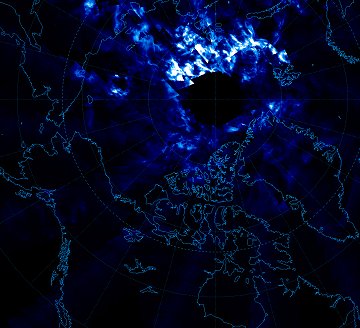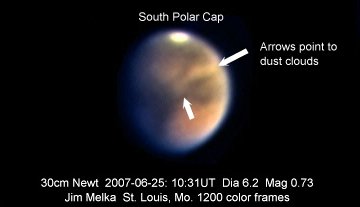 Where's Saturn? Is that a UFO--or the ISS? What's the name of that star? Get the answers from mySKY--a fun new astronomy helper from Meade. Where's Saturn? Is that a UFO--or the ISS? What's the name of that star? Get the answers from mySKY--a fun new astronomy helper from Meade. VENUS AND SATURN: Step outside this evening at sunset, just as the sky is fading to black, and look west. Venus and Saturn are having a beautiful close encounter. On Saturday, June 30th, they will be only 2/3o apart, which means you can hide them both behind the tip of your index finger held at arm's length. If you have a backyard telescope, set it up. Even small 'scopes reveal the rings of Saturn and the surprising crescent shape of Venus: sky map. NLCs FROM ABOVE: For the first time ever, humans know what a noctilucent cloud (NLC) looks like--from above. NASA's AIM spacecraft took this composite UV-wavelength picture on June 11th from a vantage point 600 km over Earth's north pole: 
Launched on April 25, 2007, AIM is on a mission to study these mysterious clouds at the edge of space; the image above represents its first good look. For the next two years, AIM will monitor the life cycle of NLCs, assaying their chemistry and particulate content, and checking to see if space dust plays a role in their genesis. When NLCs were first sighted in the 19th century, they were confined to polar latitudes, but lately they have intensified and spread with sightings in recent years as far south as Colorado and Utah. "It is clear that these clouds are changing, a sign that a part of our atmosphere is changing and we do not understand how or what it means," says AIM principal investigator James Russell III of Hampton University. Are NLCs a sign of global warming? Or something else? Researchers hope AIM will provide some answers. Stay tuned for updates. June 2007 Noctilucent Cloud Gallery
["Noctilucent Cloud"--the song] [Night-Sky Cameras] MARTIAN DUST STORM: Amateur astronomers are monitoring a growing dust storm on Mars. "A huge storm is brewing," says veteran Mars photographer Jim Melka of Chesterfield, Missouri. He took this picture on June 25th using a 12-inch telescope and digital camera: 
"Images taken on the mornings of June 25 and June 27 show the rapid growth of dust bands and clouds in just two days," he says. The instigator of the storm may be the planet's south polar cap, shown prominently at the top of Melka's image. Temperature differences between the cold polar cap and adjacent, warmer, frost-free surfaces cause cold air to come streaming off the ice, picking up dust as soon as it hits frost-free terrain: more. Amateur astronomers who wish to monitor developments must wake up before dawn and point their telescopes east, where Mars shines like a red star of 1st-magnitude: sky map. The bright polar cap and some dark markings can be seen directly in the eyepiece--no camera required. This could change, however, if the dust spreads and hides the surface. "Observers like me hope this doesn't become a global storm," says Melka. more images: from David M. Moore of Phoenix, Arizona. | 
